User:TitusVanRijn/sandbox
Works
[edit]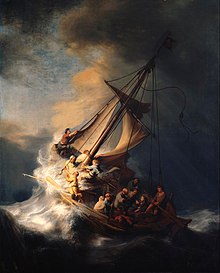

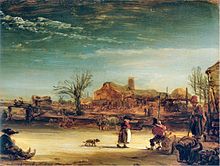
TEST
In a letter to Huygens, Rembrandt offered the only surviving explanation of what he sought to achieve through his art, writing that, "the greatest and most natural movement", translated from de meeste en de natuurlijkste beweegelijkheid. The word "beweegelijkheid" translates to "emotion" or "motive". Whether this refers to objectives, material, or something else, is not known but critics have drawn particular attention to the way Rembrandt seamlessly melded the earthly and spiritual.[1]
Earlier 20th century connoisseurs claimed Rembrandt had produced well over 600 paintings,[2] nearly 400 etchings and 2,000 drawings.[3] More recent scholarship, from the 1960s to the present day (led by the Rembrandt Research Project), often controversially, has winnowed his oeuvre to nearer 300 paintings.[a] His prints, traditionally all called etchings, although many are produced in whole or part by engraving and sometimes drypoint, have a much more stable total of slightly under 300.[b] It is likely Rembrandt made many more drawings in his lifetime than 2,000 but those extant are more rare than presumed.[c] Two experts claim that the number of drawings whose autograph status can be regarded as effectively "certain" is no higher than about 75, although this is disputed. The list was to be unveiled at a scholarly meeting in February 2010.[6]
At one time, approximately 90 paintings were counted as Rembrandt self-portraits but it is now known that he had his students copy his own self-portraits as part of their training. Modern scholarship has reduced the autograph count to over forty paintings, as well as a few drawings and thirty-one etchings, which include many of the most remarkable images of the group.[7] Some show him posing in quasi-historical fancy dress, or pulling faces at himself. His oil paintings trace the progress from an uncertain young man, through the dapper and very successful portrait-painter of the 1630s, to the troubled but massively powerful portraits of his old age. Together they give a remarkably clear picture of the man, his appearance and his psychological make-up, as revealed by his richly weathered face.[d]
In his portraits and self-portraits, he angles the sitter's face in such a way that the ridge of the nose nearly always forms the line of demarcation between brightly illuminated and shadowy areas. A Rembrandt face is a face partially eclipsed; and the nose, bright and obvious, thrusting into the riddle of halftones, serves to focus the viewer's attention upon, and to dramatize, the division between a flood of light—an overwhelming clarity—and a brooding duskiness.[8]
In a number of biblical works, including The Raising of the Cross, Joseph Telling His Dreams, and The Stoning of Saint Stephen, Rembrandt painted himself as a character in the crowd. Durham suggests that this was because the Bible was for Rembrandt "a kind of diary, an account of moments in his own life".[9]
Among the more prominent characteristics of Rembrandt's work are his use of chiaroscuro, the theatrical employment of light and shadow derived from Caravaggio, or, more likely, from the Dutch Caravaggisti but adapted for very personal means.[10] Also notable are his dramatic and lively presentation of subjects, devoid of the rigid formality that his contemporaries often displayed, and a deeply felt compassion for mankind, irrespective of wealth and age. His immediate family—his wife Saskia, his son Titus and his common-law wife Hendrickje—often figured prominently in his paintings, many of which had mythical, biblical or historical themes.
Periods, themes and styles
[edit]



Throughout his career, Rembrandt took as his primary subjects the themes of portraiture, landscape and narrative painting. For the last, he was especially praised by his contemporaries, who extolled him as a masterly interpreter of biblical stories for his skill in representing emotions and attention to detail.[13] Stylistically, his paintings progressed from the early "smooth" manner, characterized by fine technique in the portrayal of illusionistic form, to the late "rough" treatment of richly variegated paint surfaces, which allowed for an illusionism of form suggested by the tactile quality of the paint itself. Rembrandt must have realized that if he kept the paint deliberately loose and "paint-like" on some parts of the canvas, the perception of space became much greater.[14]
A parallel development may be seen in Rembrandt's skill as a printmaker. In the etchings of his maturity, particularly from the late 1640s onward, the freedom and breadth of his drawings and paintings found expression in the print medium as well. The works encompass a wide range of subject matter and technique, sometimes leaving large areas of white paper to suggest space, at other times employing complex webs of line to produce rich dark tones.[15]
Lastman's influence on Rembrandt was most prominent during his period in Leiden from 1625 to 1631.[16] Paintings were rather small but rich in details (for example, in costumes and jewelry). Religious and allegorical themes were favored, as were tronies.[16] In 1626 Rembrandt produced his first etchings, the wide dissemination of which would largely account for his international fame.[16] In 1629 he completed Judas Repentant, Returning the Pieces of Silver and The Artist in His Studio, works that evidence his interest in the handling of light and variety of paint application, and constitute the first major progress in his development as a painter.[17]
During his early years in Amsterdam (1632–1636), Rembrandt began to paint dramatic biblical and mythological scenes in high contrast and of large format (The Blinding of Samson, 1636, Belshazzar's Feast, c. 1635 Danaë, 1636 but reworked later), seeking to emulate the baroque style of Rubens.[18] With the occasional help of assistants in Uylenburgh's workshop, he painted numerous portrait commissions both small (Jacob de Gheyn III) and large (Portrait of the Shipbuilder Jan Rijcksen and his Wife, 1633, Anatomy Lesson of Dr. Nicolaes Tulp, 1632).[19]
By the late 1630s, Rembrandt had produced a few paintings and many etchings of landscapes. Often these landscapes highlighted natural drama, featuring uprooted trees and ominous skies (Cottages before a Stormy Sky, c. 1641; The Three Trees, 1643). From 1640 his work became less exuberant and more sober in tone, possibly reflecting personal tragedy. Biblical scenes were now derived more often from the New Testament than the Old Testament, as had been the case before. In 1642 he painted The Night Watch, the most substantial of the important group portrait commissions which he received in this period, and through which he sought to find solutions to compositional and narrative problems that had been attempted in previous works.[20]
In the decade following the Night Watch, Rembrandt's paintings varied greatly in size, subject, and style. The previous tendency to create dramatic effects primarily by strong contrasts of light and shadow gave way to the use of frontal lighting and larger and more saturated areas of color. Simultaneously, figures came to be placed parallel to the picture plane. These changes can be seen as a move toward a classical mode of composition and, considering the more expressive use of brushwork as well, may indicate a familiarity with Venetian art (Susanna and the Elders, 1637–47).[21] At the same time, there was a marked decrease in painted works in favor of etchings and drawings of landscapes.[22] In these graphic works natural drama eventually made way for quiet Dutch rural scenes.
In the 1650s, Rembrandt's style changed again. Colors became richer and brush strokes more pronounced. With these changes, Rembrandt distanced himself from earlier work and current fashion, which increasingly inclined toward fine, detailed works. His use of light becomes more jagged and harsh, and shine becomes almost nonexistent. His singular approach to paint application may have been suggested in part by familiarity with the work of Titian, and could be seen in the context of the then current discussion of 'finish' and surface quality of paintings. Contemporary accounts sometimes remark disapprovingly of the coarseness of Rembrandt's brushwork, and the artist himself was said to have dissuaded visitors from looking too closely at his paintings.[23] The tactile manipulation of paint may hearken to medieval procedures, when mimetic effects of rendering informed a painting's surface. The result is a richly varied handling of paint, deeply layered and often apparently haphazard, which suggests form and space in both an illusory and highly individual manner.[24]
In later years, biblical themes were often depicted but emphasis shifted from dramatic group scenes to intimate portrait-like figures (James the Apostle, 1661). In his last years, Rembrandt painted his most deeply reflective self-portraits (from 1652 to 1669 he painted fifteen), and several moving images of both men and women (The Jewish Bride, c. 1666)—in love, in life, and before God.[25][26]
Graphic works
[edit]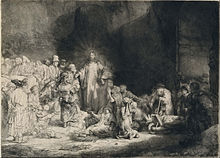

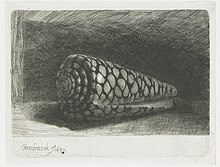
Rembrandt produced etchings for most of his career, from 1626 to 1660, when he was forced to sell his printing-press and practically abandoned etching. Only the troubled year of 1649 produced no dated work.[27] He took easily to etching and, though he learned to use a burin and partly engraved many plates, the freedom of etching technique was fundamental to his work. He was very closely involved in the whole process of printmaking, and must have printed at least early examples of his etchings himself. At first he used a style based on drawing but soon moved to one based on painting, using a mass of lines and numerous bitings with the acid to achieve different strengths of line. Towards the end of the 1630s, he reacted against this manner and moved to a simpler style, with fewer bitings.[28] He worked on the so-called Hundred Guilder Print in stages throughout the 1640s, and it was the "critical work in the middle of his career", from which his final etching style began to emerge.[29] Although the print only survives in two states, the first very rare, evidence of much reworking can be seen underneath the final print and many drawings survive for elements of it.[30]
In the mature works of the 1650s, Rembrandt was more ready to improvise on the plate and large prints typically survive in several states, up to eleven, often radically changed. He now used hatching to create his dark areas, which often take up much of the plate. He also experimented with the effects of printing on different kinds of paper, including Japanese paper, which he used frequently, and on vellum. He began to use "surface tone," leaving a thin film of ink on parts of the plate instead of wiping it completely clean to print each impression. He made more use of drypoint, exploiting, especially in landscapes, the rich fuzzy burr that this technique gives to the first few impressions.[31]
His prints have similar subjects to his paintings, although the 27 self-portraits are relatively more common, and portraits of other people less so. The landscapes, mostly small, largely set the course for the graphic treatment of landscape until the end of the 19th century. Of the many hundreds of drawings Rembrandt made, only about two hundred have a landscape motif as their subject, and of the approximately three hundred etchings, about thirty show a landscape. As for his painted landscapes, one does not even get beyond eight works.[32] One third of his etchings are of religious subjects, many treated with a homely simplicity, whilst others are his most monumental prints. A few erotic, or just obscene, compositions have no equivalent in his paintings.[33] He owned, until forced to sell it, a magnificent collection of prints by other artists, and many borrowings and influences in his work can be traced to artists as diverse as Mantegna, Raphael, Hercules Seghers, and Giovanni Benedetto Castiglione.
Drawings by Rembrandt and his pupils/followers have been extensively studied by many artists and scholars[e] through the centuries. His original draughtsmanship has been described as an individualistic art style that was very similar to East Asian old masters, most notably Chinese masters:[40] a "combination of formal clarity and calligraphic vitality in the movement of pen or brush that is closer to Chinese painting in technique and feeling than to anything in European art before the twentieth century".[41]
Asian inspiration
[edit]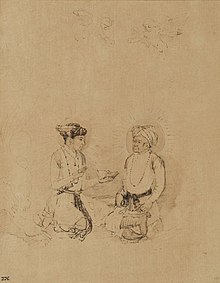
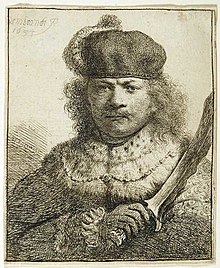
Rembrandt was interested in Mughal miniatures, especially around the 1650s. He drew versions of some 23 Mughal paintings and may have owned an album of them. These miniatures include paintings of Shah Jahan, Akbar, Jahangir and Dara Shikoh and may have influenced the costumes and other aspects of his works.[42][43][44][45]
The Night Watch
[edit]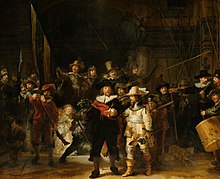
Rembrandt painted The Militia Company of Captain Frans Banning Cocq between 1640 and 1642, which became his most famous work.[46] This picture was called De Nachtwacht by the Dutch and The Night Watch by Sir Joshua Reynolds because by 1781 the picture was so dimmed and defaced that it was almost indistinguishable, and it looked quite like a night scene. After it was cleaned, it was discovered to represent broad day—a party of 18 musketeers stepping from a gloomy courtyard into the blinding sunlight. For Théophile Thoré it was the prettiest painting in the world.
The piece was commissioned for the new hall of the Kloveniersdoelen, the musketeer branch of the civic militia. Rembrandt departed from convention, which ordered that such genre pieces should be stately and formal, rather a line-up than an action scene. Instead, he showed the militia readying themselves to embark on a mission, though the exact nature of the mission or event is a matter of ongoing debate.
Contrary to what is often said, the work was hailed as a success from the beginning. Parts of the canvas were cut off (approximately 20% from the left-hand side was removed) to make the painting fit its new position when it was moved to the town hall in 1715. In 1817 this large painting was moved to the Trippenhuis. Since 1885 the painting is on display at the Rijksmuseum.[f] In 1940 the painting was moved to Kasteel Radboud; in 1941 to a bunker near Heemskerk; in 1942 to St Pietersberg; in June 1945 it was shipped back to Amsterdam.
- ^ Hughes, p. 6
- ^ "A Web Catalogue of Rembrandt Paintings". 28 July 2012. Archived from the original on 28 July 2012.
- ^ "Institute Member Login – Institute for the Study of Western Civilization". Archived from the original on 29 September 2007.
- ^ "A Web Catalogue of Rembrandt Paintings". Archived from the original on 13 May 2012. Retrieved 10 July 2007.
- ^ "Rembrandt, der Zeichner". Archived from the original on 27 May 2016. Retrieved 3 October 2007.
- ^ "Schwartzlist 301 – Blog entry by the Rembrandt scholar Gary Schwartz". Garyschwartzarthistorian.nl. 3 January 2010. Archived from the original on 22 February 2012. Retrieved 17 February 2012.
- ^ White and Buvelot 1999, p. 10.
- ^ Taylor, Michael (2007).Rembrandt's Nose: Of Flesh & Spirit in the Master's Portraits Archived 5 May 2016 at the Wayback Machine p. 21, D.A.P./Distributed Art Publishers, Inc., New York ISBN 978-1933045443'
- ^ Durham, p. 60.
- ^ Bull, et al., pp. 11–13.
- ^ Clough, p. 23
- ^ Clark 1978, p. 28
- ^ van der Wetering, p. 268.
- ^ van de Wetering, pp. 160, 190.
- ^ Ackley, p. 14.
- ^ a b c van de Wetering, p. 284.
- ^ van de Wetering, p. 285.
- ^ van de Wetering, p. 287.
- ^ van de Wetering, p. 286.
- ^ van de Wetering, p. 288.
- ^ van de Wetering, pp. 163–165.
- ^ van de Wetering, p. 289.
- ^ van de Wetering, pp. 155–165.
- ^ van de Wetering, pp. 157–158, 190.
- ^ "In Rembrandt's (late) great portraits we feel face to face with real people, we sense their warmth, their need for sympathy and also their loneliness and suffering. Those keen and steady eyes that we know so well from Rembrandt's self-portraits must have been able to look straight into the human heart." Gombrich, p. 423.
- ^ "It (The Jewish Bride) is a picture of grown-up love, a marvelous amalgam of richness, tenderness, and trust... the heads which, in their truth, have a spiritual glow that painters influenced by the classical tradition could never achieve." Clark, p. 206.
- ^ Schwartz, 1994, pp. 8–12
- ^ White 1969, pp. 5–6
- ^ White 1969, p. 6
- ^ White 1969, pp. 6, 9–10
- ^ White, 1969 pp. 6–7
- ^ Christiaan Vogelaar & Gregor J.M. Weber (2006) Rembrandts Landschappen
- ^ See Schwartz, 1994, where the works are divided by subject, following Bartsch.
- ^ Benesch, Otto: The Drawings of Rembrandt: First Complete Edition in Six Volumes. (London: Phaidon, 1954–57)
- ^ Benesch, Otto: Rembrandt as a Draughtsman: An Essay with 115 Illustrations. (London: Phaidon Press, 1960)
- ^ Benesch, Otto: The Drawings of Rembrandt. A Critical and Chronological Catalogue [2nd ed., 6 vols.]. (London: Phaidon, 1973)
- ^ Cite error: The named reference
Hockney2014was invoked but never defined (see the help page). - ^ Slive, Seymour: The Drawings of Rembrandt: A New Study. (London: Thames & Hudson, 2009)
- ^ Silve, Seymour: The Drawings of Rembrandt. (London: Thames & Hudson, 2019)
- ^ Mendelowitz, Daniel Marcus: Drawing. (New York: Holt, Rinehart & Winston, Inc., 1967), p. 305. As Mendelowitz (1967) noted: "Probably no one has combined to as great a degree as Rembrandt a disciplined exposition of what his eye saw and a love of line as a beautiful thing in itself. His "Winter Landscape" displays the virtuosity of performance of an Oriental master, yet unlike the Oriental calligraphy, it is not based on an established convention of brush performance. It is as personal as handwriting."
- ^ Sullivan, Michael: The Meeting of Eastern and Western Art. (Berkeley/Los Angeles: University of California Press, 1989), p. 91
- ^ Schrader, Stephanie; et al. (eds.): Rembrandt and the Inspiration of India Archived 1 August 2020 at the Wayback Machine. (Los Angeles, CA: J. Paul Getty Museum, 2018) ISBN 978-1606065525
- ^ "Rembrandt and the Inspiration of India (catalogue)" (PDF). Archived (PDF) from the original on 18 October 2019. Retrieved 18 October 2019.
- ^ "In Paintings: Rembrandt & his Mughal India Inspiration". 3 September 2017. Archived from the original on 23 May 2018. Retrieved 12 May 2018.
- ^ Ganz, James (2013). Rembrandt's Century. San Francisco, CA: Fine Arts Museum of San Francisco. p. 45. ISBN 978-3791352244.
- ^ Beliën, H & P. Knevel (2006) Langs Rembrandts roem, pp. 92–121
Cite error: There are <ref group=lower-alpha> tags or {{efn}} templates on this page, but the references will not show without a {{reflist|group=lower-alpha}} template or {{notelist}} template (see the help page).
